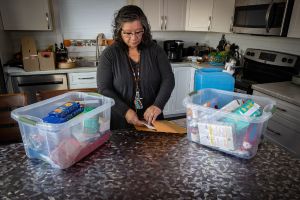An emergency can happen at any time. It’s important to be prepared so you can respond quickly. Here at Canadian Red Cross, we’re celebrating Emergency Preparedness Week with a roundup of key preparedness tips that are essential for every household.
A little preparation goes a long way. Here are three simple steps you can follow to stay prepared for an emergency: know the risks, make an emergency plan, and get an emergency kit.
For a quick summary, download our Red Cross’ Be Ready Brochure. You can also check out our Be Ready Pocket Guide to assist you with developing your emergency plan.
1. Know the risks in your community.

Depending on where you live in Canada, you may be subject to several risks, including but not limited to floods, earthquakes, winter storms, power outages, tornadoes, wildfires, industrial accidents, or transportation obstructions. Knowing the risks in your community and places you travel is the first step to prepare yourself and your household for an emergency.
One way to assess the risks in your community is by contacting your local municipality and asking about hazard risks in your area. You can also ask if there is a community preparedness plan in place in case of an emergency. Make sure to stay up to date on local weather conditions and weather alerts.
As a household, it’s important to consider:
- Do you live alone or with others?
- Do you live with children or people with health problems or mobility issues?
- Do you live in a high-rise, basement suite, or ground-level home?
- Do you live near water? Near power lines? In a forest? On a busy highway?
2. Make an Emergency Plan

Make an emergency plan and review it with your household to ensure you are prepared in the event of a disaster or emergency. You can download a free, fillable version of the Canadian Red Cross emergency plan in multiple languages to ensure you are prepared.
When developing an emergency plan, consider these points:
- Key information to include in your emergency plan such as health card numbers, passport numbers, driver’s license numbers, insurance, and phone numbers.
- Identify all exit routes in your home for different types of emergencies.
- Prepare to be self-sufficient in your home for three days, as recommended by the Government of Canada during emergencies.
- Plan for evacuating with small children and pets. A roundup of resources and activities to help prepare for an emergency with small children is available in this free expect the unexpected guide for parents.
- Establish safe meeting places within the community and outside the community.
- Familiarize yourself with community emergency plans and evacuation routes.
- Consult with your neighbours to identify who may require extra assistance, or who you can turn to for support if needed.
- Make multiple copies of the plan so each member of your household has a copy. You may also consider keeping a copy in your car, at work, and on your cellphone.
- Keep a copy of your emergency plan in a place that’s easy to find and easy to remember.
- It is recommended to give a copy to your close family and friends, coworkers, neighbours, or other caregivers or children’s caregivers if applicable.
- Older adults should consider reviewing this page: emergency preparedness for older adults for extra tips on emergency preparedness.
Once you’ve taken all of this into consideration and created an emergency plan, consider what supplies you’ll need in the event of an emergency, and get an emergency kit.
3. Make or Buy an Emergency Kit

The Canadian Red Cross recommends creating or purchasing an emergency kit with enough supplies to meet your household’s needs during an emergency for three days. This includes three days’ worth of non-perishable food, water, medications, and personal items. See our recommended list of items to include in your Shelter-In-Place kit.
In the event you must leave your home, we recommend creating an emergency evacuation kit. The items in each kit will vary and depend on your household’s needs. For more information on what to include, visit our list of items to include in your Emergency Evacuation Kit, which is available in multiple languages.
If you would prefer to purchase a kit, rather than building your own, you can purchase emergency preparedness kits directly from our website. If you’re still scrambling to decide what to include in your kit, download our Build or Buy a kit guide for a more extensive list of items and information, or watch our video.
Once you’ve created or purchased your emergency kit, be sure to keep all items together in a sturdy bag that’s easy to carry. Store the kit in a place that’s clean, dry, and easy to access. Make sure everyone in your home knows where the emergency kit is stored and can reach it in the event of an emergency.
It’s important to check your emergency kit every year to ensure there are no expired items and all items are in working condition (especially flashlights, radios, extra cables, etc.).
Share these essential emergency preparedness tips with your friends, family members, neighbours, and colleagues so we can all be prepared in the event of a disaster or emergency.
For more information on emergency preparedness, visit our Emergency Preparedness and Recovery page.
Additional information and resources on emergency preparedness and planning can be found on the Government of Canada’s Get Prepared page.

